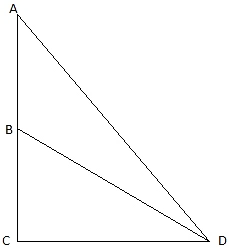On a horizontal plane, there is a vertical tower with a flagpole on the top of the tower. At a point, 9 meters away from the foot of the tower, the angle of elevation of the top and bottom of the flagpole is 60° and 30° respectively. Find the height of the tower and the flagpole mounted on it. [Take √3 = 1.73.]

In the above figure, let BC be the tower, AB is the flagpole. Let D be the point 9 m away from C such that the angle of elevations of the top and bottom of the flagpole AB are 60° and 30° respectively. Join C and D. We get two triangles ADC and BCD with right angle at C. We have to find the height of the tower BC and the height of the flagpole AB. For this, we use trigonometric ratio tan for triangles ACD and BCD to find AC and BC respectively. Subtract BC from AC to find AB.
Now we have, DC = 9 m, ∠ADC = 60°, and ∠BDC = 30°. We are to find AB and BC.
From ∆ACD,
![]()
or,
![]()
From ∆BDC,
![]()
or,
![]()
Now,
![]()
And, BC = 9/1.73 = 5.20 m